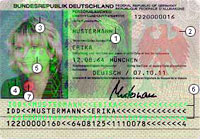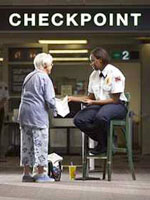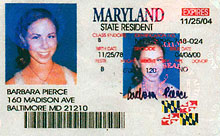What’s Wrong With Showing ID?
“There are good people with bad papers; and bad people with good papers.”
– Bertolt Brecht
What does an ID, any ID, do for security? The honest answer is ‘not much’. If anything, relying on ID for security purposes actually makes things worse: a false sense of security fosters complacency.

Showing ID only affects honest people. If you’re dishonest, you can obtain false documents or steal the identity of an honest person.
If a 19 year-old college student can get a fake ID to drink, why couldn’t a bad person get one, too? And no matter how sophisticated the security embedded into the ID, wouldn’t a well-financed terrorist be able to falsify that, too? The answer to both questions is obviously ‘yes’.
Honest people, on the other hand, go to Pro-Life rallies. Honest people go to Pro-Choice rallies, too. Honest people attend gun shows. Honest people protest the actions of the President of the United States. Honest people fly to political conventions. What if those with the power to put people on a ‘no fly’ list decided that they didn’t like the reason for which you wanted to travel? The honest people wouldn’t be going anywhere.
Bad people, besides using fake IDs and stolen identities, can also make the system of checking IDs work in their favor. The Carnival Booth algorithm, as described by researchers at the Massachusetts Institute of Technology, demonstrates that terrorists can probe an ID security system by sending a number of people on innocent trips through the system and noting who is flagged for extra searches and who isn’t. They then send only those who the system doesn’t flag on terrorist missions.
Requiring people to show ID enables both surveillance and control of travel. Once you are identified, your activities — including your movements — can be recorded in permanent government files linked to your identity. Decisions about whether to not to permit you to travel or engage in other activities can be based on your identity and the travel history and other data linked to that identity.
Forcing travelers to identify themselves, and entering that information in widely distributed and widely accessible databases such as airline reservation systems, exposes them to threats — malign foreign governments, stalkers, domestic abusers, industrial espionage, etc. — that they wouldn’t face if they were traveling anonymously.
None of this is possible if you travel anonymously. “Do Not Collect” is the most fundamental principle of “privacy by design”, and anonymity is the most basic element of protection against abuse of Big Data.

Still, some Americans think that “if you have nothing to hide, you have nothing to fear”. Were the Founding Fathers criminals trying to protect themselves when they inserted the 4th and 5th amendments into the Bill of Rights? After all, nobody who hasn’t done anything wrong needs to worry about being searched or being forced to testify against himself.
Over the years, Americans have become accustomed to showing ID in any number of circumstances. Few have asked the question, “Why?”. Showing ID during a private business transaction, like writing a check or using a credit card, is different than having to show ID to the government in order to travel.
The custom of showing ID at airports came about in July of 1996, in the wake of the TWA flight 800 disaster. Faulty fuel tank insulation caused TWA 800 to explode over Long Island Sound. Before we knew that, there was concern that terrorists had blown up the plane. According to former terrorism czar Richard Clarke’s book (“Against All Enemies: Inside America’s War on Terror”, pp. 122-124), the ID requirement was instituted as a temporary measure so that then-President Clinton had something to announce to the families of the victims when he met with them, before the cause of the crash was known:
He [Clinton] called us into the Oval Office.”I want to go up there tomorrow, to see those families.”
That did not seem like the best idea I had ever heard…. I suggested there might be problem with meeting the families in their current mood….
As we were leaving the Oval Office, he had one more thought. “And I want to announce new airline security measures while I’m at Kennedy [Airport]. So develop some.”…
We had been working… on the ideas of a Commission on Aviation Safety and Security… Now, however, the President wanted some new security measures announced immediately. I called Flynn, “Tell your lawyers they’re not going home tonight.”
In the morning I flew with the President and the First Lady to Kennedy International and briefed them aboard Air Force One on the announcement he would make. From now on, no one would be allowed to board an aircraft without a government-issued ID that matched the name on the ticket….
[T]he President stood at a podium in front of Air Force One and made the new security announcements. He then left for the Olympics…. I was left alone on the tarmac. An FBI agent drove me to LaGuardia to catch the shuttle back to Washington. A long line snaked out of the Marine Air Terminal [at LaGuardia Airport]. The guy in front of me explained, “New security stuff. You have to have a photo ID.”
After the 2001 World Trade Center bombings, the ID requirement became effectively mandatory, as anyone who has flown since can testify.
The Department of Homeland Security has attempted to institute programs predicated on the use of ID to improve air security. One such program, originally called the Computer Assisted Passenger Profiling System II (CAPPS II) and later put into effect as Secure Flight and the Automated Targeting System (ATS), effectively requires every citizen to undergo a background check as a precondition to travel by commercial airline. The CAPPS II program was pronounced ‘dead’ in July of 2004, but the Department of Homeland Security quietly continued to work to produce a replacement system, called “Secure Flight”, that is now in place and that works similarly.

Secure Flight and the Automated Targeting System depend on the presentation of government-issued photo ID in order to function. The information contained on the ID is cross-checked against a variety of public and private databases, and an individual threat assessment is generated based on this information.
Another program which depends on showing ID is the system of blacklists (“watch lists” and no-fly lists. The federal government creates these lists through secret, extrajudicial procedures, and requires airlines to request ID from passengers and send passenger information to the government in order to check them against the secret lists and algorithms. This has resulted in countless citizens with names similar to blacklisted people being harassed, arrested, or prevented from traveling by aircraft — including, for a while, every person named “David Nelson”.
Much has been done to make travel by air safer. Cockpit doors have been secured, pilots are armed, and Air Marshals patrol airplane cabins. Increased physical security at airports has dramatically increased the safety of our nation’s skies. Above all, the mindset of the flying public has also changed: no longer will passengers remain passive in the event of a skyjacking.
The demand for ID does nothing for security while making honest Americans less free.
Every government that has imposed totalitarian rules told its populace that it was doing so to “uphold freedom” or “improve the security of the homeland” or “root out terrorists and subversives.” These ends do not justify unconstitutional means. We uphold freedom by exercising it – not by restricting it.
Using this country’s transportation system to conduct a dragnet, using secret government lists of wanted people, degrades our freedom and makes people less inclined to voice their opinion for fear of ending up on these secret lists. While the present administration may have benevolent intentions to justify their actions, our future is imperiled by this wholly un-American activity.
The shift from physical ID cards to digital IDs and automated facial recognition enables a further expansion of ID-based surveillance, logging, and control of movement. Automated identification can be carried out remotely and invisibly. It enables surveillance and control to be outsourced to airlines and airport operators through public-private surveillance partnerships and displaced from obvious government checkpoints to invisible virtual checkpoints and from US borders and ports of entry to foreign airline ticket sales and check-in locations. It allows asylum claims to be denied remotedly and prematurely, before asylum seekers even reach a place (on US soil at a border crossing or on arrival at a US airport) where they can make or argue a claim for asylum.
The right to travel is recognized in the First Amendment to the US Constitution as “the right of the people… peaceably to assemble”, and the right to freedom of movement is recognized in international human rights treaties signed and ratified by the US. But Congress, Federal and state agencies, and US courts have too often failed to uphold their duty to protect those rights. We work to raise awareness of these fundamental rights, their importance, and the ways they are threatened. We support legislation and regulatory action to fully protect these rights, and litigation when necessary to defend them against encroachment. We support individuals who exercise and stand up for their rights.